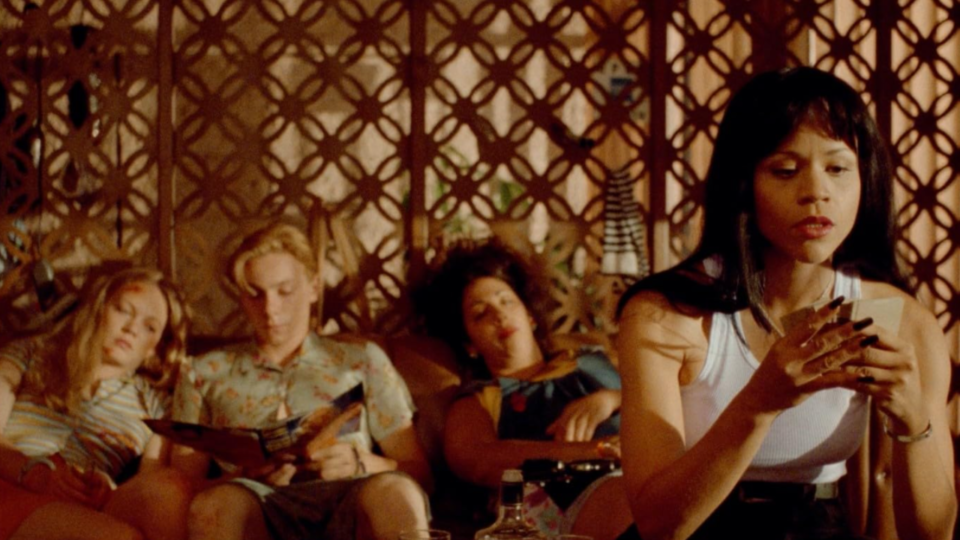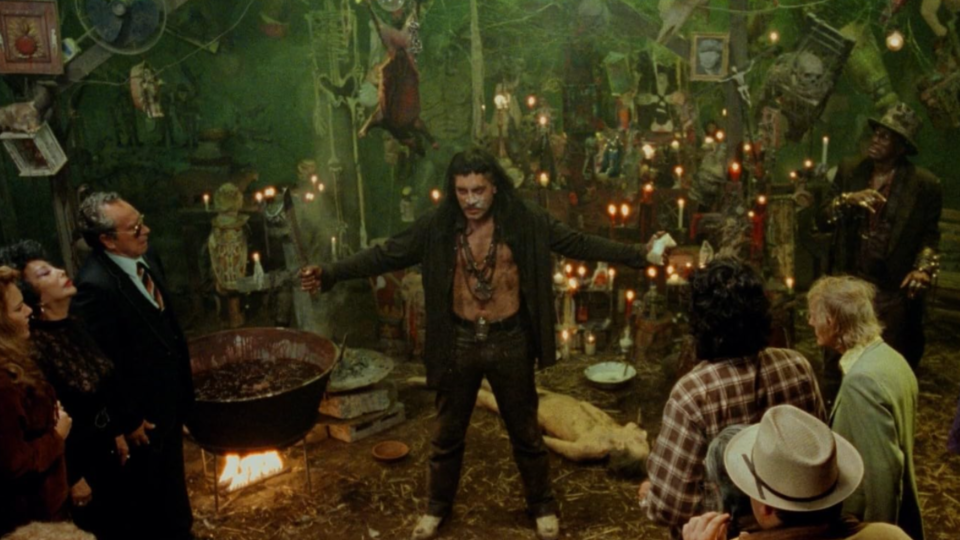‘Perdita Durango’: Supernatural Occurrences And Mexican Faith

The genre of grindhouse cinema has been a major part of the film industry. From Blaxploitation films to Women in Prison films and any other exploitation style of films, these stories push boundaries with a gritty aesthetic. Within each decade there are certain directors that take this style of filmmaking and make it theirs. Modern examples would be Quentin Tarantino and Robert Rodriguez. Since the 1990s, the two directors have had a hold on this genre while leaving an indescribable impact on other filmmakers. But when speaking about 90s exploitation films, there’s a Spanish director who deserves just as much attention and love.
Álex de la Iglesia is a household name when speaking about the Spanish horror genre. He manages to weave humor seamlessly within his horror films. However, there is one feature in particular where he moved the comedy to the side to create a chaotic crime horror film. The film in question, Perdita Durango, has garnered a cult following since its American censored release in 1997. Now, the uncensored version with a bloodied Jesus yelling in agony and all, is available to Americans. While Perdita Durango resembles the exploitation films of Tarantino and Rodriguez, Álex de la Iglesia adds his own charm to the film. He brings to life the border towns as his story flows between Mexico and the United States. In a hellscape nightmare narrative, de la Iglesia shifts between the supernatural, mafia-ridden streets, and blood-soaked rituals.
Also Read: ’30 Coins’ Creator On Season 2 and Paul Giamatti
Perdita Durango follows the titular character (Rosie Perez) attempting to cross the border back into the United States. While on her journey, she comes across a man radiating charisma with a hint of chaos. Romeo de la Rosa (Javier Bardem) approaches Perdita. He’s a drug dealer, bank robber, Santeria priest, and much more. So, of course, Perdita joins Romeo in his latest job for the money. This leads to a deranged killing spree as the two encounter bad omens, stubborn DEA agents, and traitorous criminals. To start off their new life together as on-the-lamb criminals they agree to kidnap a couple of Americans for one of Romeo’s santeria rituals.

Romeo only performs two rituals throughout the whole film. Even then, de la Iglesia places a huge significance on them. For starters, this is Romeo’s main source of income. He gathers people around within an abandoned house to showcase his powers. This ceremony is his science. According to Romeo, his rituals are only possible through the powers of a necklace. The necklace was given to him in his adolescence. We see this through a flashback at the film’s midpoint. Romeo believes that without his necklace, bad luck follows. The first ceremony Romeo performs on screen is blood-soaked, cocaine-filled, and disturbing. Romeo’s hacksaws at a cadaver. He cuts off the arm with a rusted machete while screaming,
“The saint is born from the dead”
Romeo continues his Santeria and voodoo hybrid ritual with the help of Adolfo (Screamin’ Jay Hawkins). While this intense ritual continues, de la Iglesia makes it a point to constantly revert back to the audience. Some are in utter disbelief while others are experiencing pure terror. One of them, Dumas (James Gandolfini), stands with a neutral face videotaping the whole ceremony.
Also Read: Gigi Saul Guerrero: The Face of Mexican American Horror Cinema [Horror En Español]
The constant back and forth between Romeo and the audience is an important factor when thinking about one of the film’s themes. As we’ll later get into, the skepticism surrounding Romeo’s science and religious beliefs is in question through the first half of the film. De la Iglesia presents the “science” as supernatural occurrences in the form of good and bad luck. Let’s pull back away from Romeo’s first ceremony and return to Perdita’s and Romeo’s initial greeting. The first thing we and Perdita hear Romeo say is
“Today is your lucky day.”
Now if uttered by any other person the phrase comes off as cocky and arrogant. However, I firmly believe Romeo says this statement as more than just a pickup line. Talk of good luck and bad omens repeatedly come up in conversation between Perdita and Romeo. Dumas has his fair share of conversations regarding people being skeptical about Mexican supernatural beliefs. To bring this back to Romeo’s first ceremony, the idea of luck never appears. But, de la Iglesia purposely disregards this form of supernatural for a reason. Instead, he leaves the viewers with a sense of voyeurism. We’re left as a fly on the wall. He wants us to ponder whether Romeo indeed has a connection with the other world or if his performance is nothing but a sham.

Also Read: Re-Creating Chile’s Horrific History With Surrealist Animation [Horror En Espanol]
A factor that helps add to the question of whether Romeo is genuine in his beliefs is the use of potential magical realism that runs in the background. This first comes into play at the beginning of Perdita Durango. While crossing the border into the United States, he explains how his plan to receive a large sum of money is in effect. The first order of business is transporting a cadaver, the same one used in the first ceremony, across the border. Once Perdita finds out about the predicament Romeo put her in, she decides to leave. Only with a calm demeanor, Romeo tells her to
“Trust in my science, believe that.”
Afterward, he places his necklace on top of the covered dead body in the backseat with his necklace. A border patrol officer stops them at the checkpoint and begins to search the car. As the officer lingers over the blanket covering the cadaver, de la Iglesia makes it a point to have the necklace center view. This frame gives the necklace a spirit-like essence. From here on out the question arises about Romeo’s possible good luck and science.
Also Read: ‘The Last Matinee’: A New Perspective Through Stolen Innocence [Horror En Español]
When thinking about the possibilities of the supernatural, I believe de la Iglesia answers the question at the midpoint of the film. Before reaching this point in the narrative, Romeo and Perdita successfully kidnap a pair of güeros to kill for the next ritual. Estelle (Aimee Graham) and Duane (Harley Cross) are the unlucky pair who come across Perdita and Romeo. When getting close to crossing the border back into Mexico, Dumas stops by a small Texas Sheriff’s Department for help. There he meets Sheriff Doyle (Alex Cox) who has heard of Romeo. He mentions how there’s no way he survived the ambush in Del Rio without magic. Dumas blames it on good luck. Regardless of what it was, Doyle agrees to help capture Romeo. This leads to the midpoint of the film, Romeo’s second ritual.
Romeo’s second ritual follows the same chaotic pattern of drugs, blood, and Santeria. But, there’s a key difference: he is to sacrifice Estelle in front of the audience whereas before his rituals included dead bodies. Unbeknownst to Romeo, this ritual is going to be cut short. This is due to the consequences of betraying a former friend Shorty Dee (Santiago Segura). In the midst of the blood-filled shoot-out, Shorty Dee removes Romeo’s necklace.
Also Read: ‘Welcome to Hell’: An Argentinian Take On Heavy Metal Horror [Horror En Español]
This is the turning point for Romeo. The necklace is gone and Romeo flees for his life with Perdita, Duane, and Estelle. This is when de la Iglesia makes his point about the supernatural. While catching the failed ritual through the security of his vehicle, Doyle brings up the possibility of Romeo being a nahual because of his tendency to always come out of situations scathe-free. While Doyle says it as a joke, Dumas is firm in his stance that there is a higher work at play.
“Stuff works if you believe in it.”
What’s interesting about this sequence in the car, is that this is the only time we hear Dumas mention having faith in a god/higher power. Other than that he considers everything happening good and bad luck. Unfortunately for Romeo, his good luck has turned for the worse after losing his necklace. He loses his good luck, and in a way loses his faith in the gods without ever explicitly stating it.
Also Read: El Santo: Celebrating Mexico’s Biggest Horror Icon
The second half of the film focuses on the bad luck that transpires as he tries to finish his last job with Perdita. Good and bad luck is never in question again after the ritual. With that, the supernatural essence in the film dissipates as well. We are left with Romeo wandering around Mexico and the United States with nothing but bad luck on his side.

Álex de la Iglesia’s filmography has its highs and lows just like any other director. With over twenty credits from the date of this publication, it’s safe to say you’re in good hands when de la Iglesia treads the familiar genre of horror comedies. But there is truly something special and unique about Perdita Durango. De la Iglesia weaves subgenres throughout his narrative while handling complicated scenes and themes. His approach to the supernatural is just a small element within the chaotic gem that is Perdita Durango.
Categorized:Editorials Horror En Espanol

